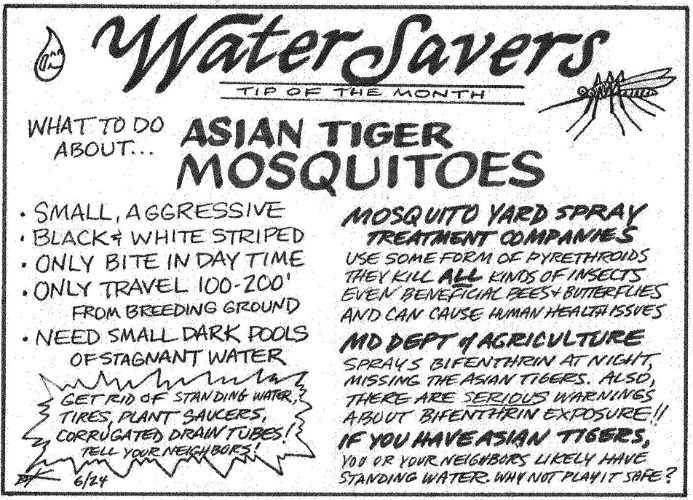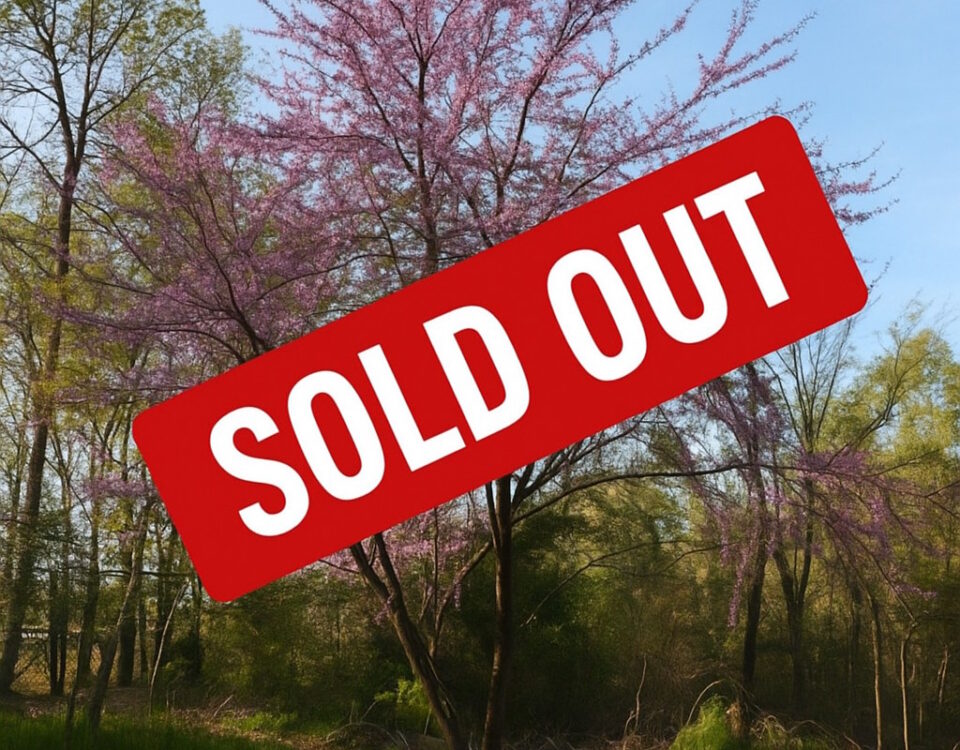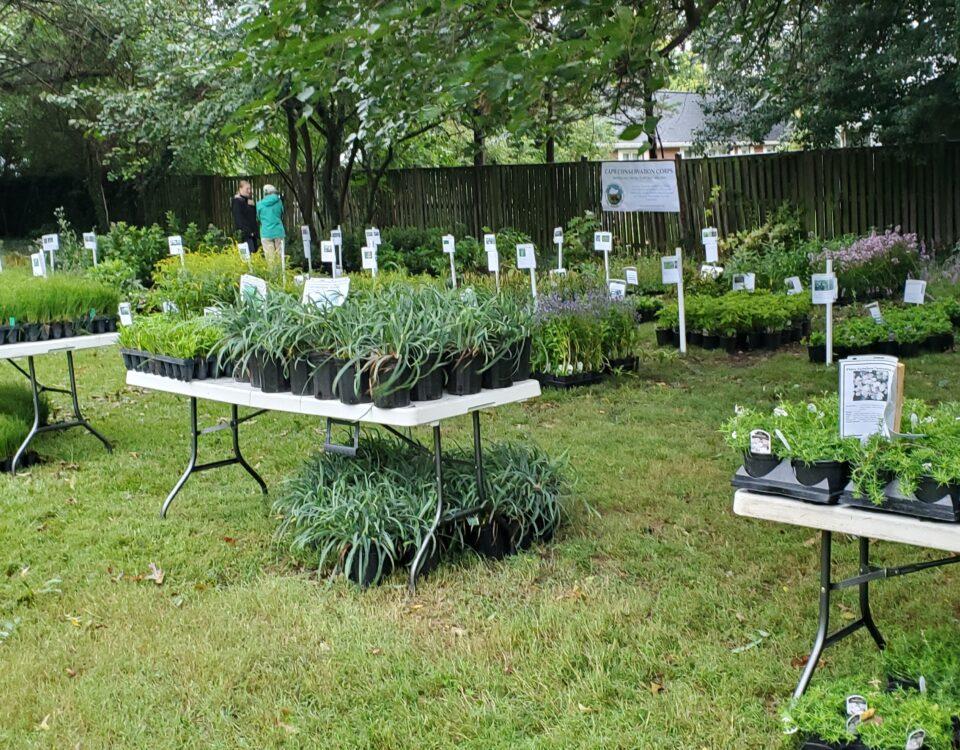
Alternatives to Mosquito Control
April 24, 2017
Gardening With Nature in Mind
July 26, 2017By: Stacey Wildberger
“What will it take to give our local animals what they need to survive and reproduce on our properties? NATIVE PLANTS, and lots of them” –Douglas Tallamy
Last month we hosted a screening of award winning director, Catherine Zimmerman’s film Hometown Habitat along with the CSC Garden Club. The film shows several different areas of the country and how each of them has used native plants to restore habitat. We know that nature can no longer exist “somewhere out there” (Douglas Tallamy) because we have destroyed so much habitat through development. Nature is running out of places to go. If we can turn our own backyards into usable habitat through the planting of native plants we can help bring nature home. Native flora and fauna have co-evolved together over millions of years and depend on each other for life services. Many insects are so specialized that they have only one host plant that they can lay their tiny eggs on. We can provide those in our own backyards.
Many people have a notion that native plants are messy or weedy but Europeans have used our native plants in formal gardens for centuries—they are their exotics. Another misconception people have is that they must use these non-native plants because insects won’t damage them. If you let nature do her job the good bugs will take care of the pests. A non-native plant or shrub that has no insects on it is not supporting nature. The spicebush butterfly uses the spice bush tree as its host plant to lay its eggs on—it only takes 3 leaves to raise that caterpillar into a beautiful butterfly: you will never notice the 3 leaves that baby ate.
Doug Tallamy, professor of Entomology & Wildlife Ecology at the University of Delaware, author of Bringing Nature Home and narrator of the film we screened, Hometown Habitat, compared the native trees in his yard to the non-natives his neighbor grows to count the species of caterpillars each supports. What he found by looking at a 12’ area, eye level on his native White oak tree was 233 caterpillars, 15 species and on his Black cherry he found 53 caterpillars, 10 species. When he observed the non-native Burning bush in his neighbors’ yard there were 2 caterpillars, 1 species and the Callery pear had 1 caterpillar, 1 species. When he stepped back to assess the “damage” done by all those caterpillars on his beautiful white oak -he saw none!
One of the great wonders of spring is seeing new life forming. Many of us can witness this in our own backyards when birds choose our yard to set up their nest and mate. I know many of us set out feeders with seed to supplement the diets of the backyard birds, but seed only helps the adult birds. About 96% of all birds rely on insects to raise their young. Without resources such as the mighty oak, the black cherry, willow, birches, maples and poplar trees to host the caterpillars needed to feed those baby birds nesting in our yards, many will not survive to adulthood. It takes almost 9,000 caterpillars to raise a clutch of chickadees! An oak will support 534 species of caterpillars, the black cherry 456 and the willow 455!
There are so many wonderful native shrubs and trees to choose from that are not only beautiful but life giving to the creatures around us. When shopping this spring and fall please be mindful that big box stores and many nurseries are still selling highly invasive non-native plants. Look for native alternatives to use instead! Following is a list of common known invasives still being sold in nurseries that will kill off native plants, choke out trees and invade our natural spaces. Educate yourself before you buy! Avoid these plants:
Vines
 DON’T PLANT: Lonicera japonica (Japanese honeysuckle), a highly invasive vine that will twist around herbaceous plants and smother them.
DON’T PLANT: Lonicera japonica (Japanese honeysuckle), a highly invasive vine that will twist around herbaceous plants and smother them.
DO PLANT: a beautiful native honeysuckle and great hummingbird nectar
DON’T PLANT: Wisteria sinensis (Chinese wisteria) that will girdle surrounding trees causing death.
DO PLANT: Wisteria frutescens (American Wisteria) same beautiful flowers without the crazy spread!
DON’T PLANT: Clematis ternifolia Sweet autumn clematis: highly aggressive
DO PLANT: Clematis virginiana (virgin’s bower) is a native clematis
DON’T PLANT: Hedera helix (English Ivy) will spread into the tree canopy blocking off sunlight to the host tree, Euonymus fortune (winter creeper) or Vinca minor/major (common periwinkle) will displace plants and seedlings, creeping into forest breaks.
DO PLANT: Antennaria plantaginifoli (pussytoes), Asarum canadense (Wild ginger), Carex species (various sedges) Tradescantia virginiana (spider lily) and Packera aurea (Golden ragwort).
DON’T PLANT: Phylloastachys (Bamboo) which will form tough, mat like structures choking out native flora and spreading into your neighbor’s yard.
DO PLANT: For screening, consider Ilex opaca (American Holly) or Morella Pensylvanica (Bayberry.)
DON’T PLANT: Miscanthus sinenesis. It is an aggressive seeder that birds move into natural areas, crowding out important native grass species.
DO PLANT: Panicum virgatum (switchgrass) OR Andropogon gerardi (big blue stem)
Shrubs
DON’T PLANT: Euonymus alatus (Winged burning bush) is a highly invasive shrub that threatens a variety of habits by forming dense thickets displacing the native plants.
DO PLANT: Fothergilla major (witch alder), Itea virginica (Virginia sweet spire), Aronia arburtifolia (red chokeberry), Aronia melanocarpa (black chokeberry) and many varieties of Viburnum provide equally beautiful if not MORE BEAUTIFUL fall color!
DON’T PLANT: Nandina domestica nandian/sacred bamboo is a shade tolerant shrub which allows it to easily invade forest edges and interiors and is spread by birds eating their berries, which have been known to cause death to cedar waxwings.
DO PLANT: Ilex Glabra (Inkberry), Ilex verticillata (Winterberry) and Callicarpa americana (Beautyberry) are beautiful shrubs that produce safe berries for all birds
DON’T PLANT: Ligustrum sinese (Chinese privet) forms dense thickets
DO PLANT: Morella pensylvanica (Bayberry), Ilex glabra (inkberry), Aronia arbutifolia (red chokeberry), Viburnum prunifolium (Black haw) all make great hedges.
DON’T PLANT: Elaegnus umbellate (Autumn Olive) will out compete natives, create dense shade and interfere with natural plant succession.
DO PLANT: Appropriate alternatives include the previously mentioned shrubs as well as Aronia arbutifolia (red chokeberry), Itea virginica (Virginia sweetspire).
DON’T PLANT: Berbis Thumergii (Japanese Barberry) not only displaces native species but it can change the soil chemistry and is a GREAT TICK HABITAT! Spirea japonica (Japanese spirea)
DO PLANT: Physocarpus opulifolius (ninebark) is a wonderful alternative providing purple leaf color
DON’T PLANT: Pyrus calleryana (Callery pear) can be seen up and down the side of many highways and neighborhood streets because they spread like wildfire. It produces millions of seeds that are spread by the birds forming dense thickets of wasteland.
DO PLANT: Amelanchier spp. (serviceberry) or Cornus florida (dogwood) are beautiful native trees with tremendous wildlife value.
Thanks again to Cape Ace hardware for sponsoring the screening—making the evening a free event for the community. We appreciate their continued community support! Thanks ACE!







